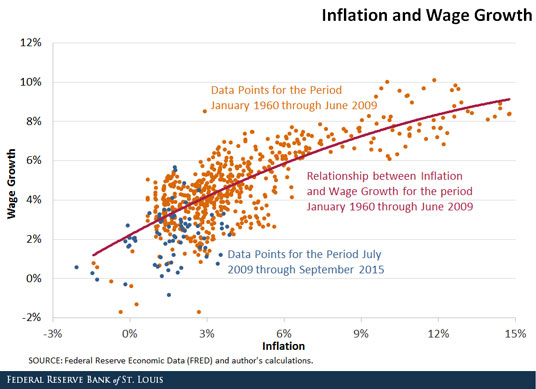The Relationship between Wage Growth and Inflation
What is the relationship between inflation and wage growth? The figure below is a scatterplot of:
- Year-over-year inflation, using the consumer price index for all urban consumers
- Year-over-year wage growth, using the ratio of compensation of employees to total nonfarm employees as the measure of wages
Each of the orange circles represent a month of the period January 1960 through June 2009, the end of the Great Recession. The blue circles are represent July 2009 through September 2015. The curved red line shows the relationship between inflation and wage growth for the period January 1960 through June 2009.
The positive slope of the curved line indicates that as inflation increases, wage growth also rises. Real wage growth—or the difference between wage growth and inflation—would be independent of inflation if the slope of the line was constant and wages increase one to one with inflation. In fact, the slope of the line declines with inflation, indicating that periods of higher inflation (especially higher than 6 percent) were also periods of lower real wage growth.
Recently, wage growth and inflation have been low relative to U.S. history, as indicated by the fact that the blue circles are in the bottom-left of the figure. Perhaps more importantly, this figure shows that, even conditional on inflation, wage growth has been low recently, as most of the blue circles are below the fitted line.
In a frictionless economy, such a reduction in wage growth would be a consequence of slower growth in labor productivity or output per hour. That decline in labor productivity actually occurred: Output per hour worked grew at an average yearly rate of only 1.2 percent from the third quarter of 2009 to the second quarter of 2015, while it grew at an average yearly rate of 2.1 percent from the first quarter of 1960 through the second quarter of 2009.1
Notes and References
1 Nonfarm business sector: real output per hour of all persons, percent change from a year ago, quarterly, seasonally adjusted.
Additional Resources
- On the Economy: Why Are More Young Adults Still Living at Home?
- On the Economy: Predicting the Impact of Oil Prices on Inflation
- On the Economy: Which Regions Have Recovered from the Great Recession?
Citation
Juan M. Sánchez, ldquoThe Relationship between Wage Growth and Inflation,rdquo St. Louis Fed On the Economy, Nov. 9, 2015.
This blog offers commentary, analysis and data from our economists and experts. Views expressed are not necessarily those of the St. Louis Fed or Federal Reserve System.
Email Us
All other blog-related questions



